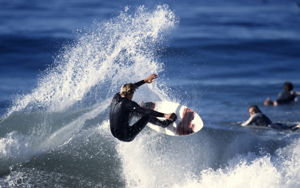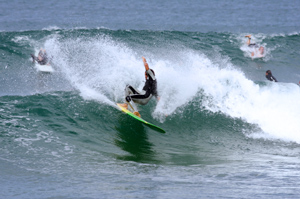How to Surf Switchfoot
 Why choose? All surfers start out learning to surf with either a regular foot (left foot forward) or goofy foot(right foot forward) stance. For the vast majority of surfers, the stance they begin with not only becomes their overwhelmingly dominant stance, it remains their only stance.
Why choose? All surfers start out learning to surf with either a regular foot (left foot forward) or goofy foot(right foot forward) stance. For the vast majority of surfers, the stance they begin with not only becomes their overwhelmingly dominant stance, it remains their only stance.
Just because someone feels more comfortable surfing either regular or goofy foot doesn’t mean that they shouldn’t strive to surf switchfoot and occasionally shred with the opposite food forward. So if you’re like most surfers and have become a creature of habit when it comes to your surfing stance, this guide’s for you.
Limitation of Rights & Lefts
A lot of regular foot surfers prefer to surf right-handed breaks, while goofy foot surfers generally prefer to surf left-handed breaks. This is because most surfers have stronger frontside turns than backside turns. There are two very legitimate reasons for this:
- Ankles, knees, and hips are designed for forward flexion, which results in much more control and the ability to make micro adjustments in weight distribution.
- When you're facing the wave, it’s much easier to assess and anticipate changes in wave shape — also conducive to proactive rather than reactive surfing.
To be the best and most well-rounded surfer you can be means being as comfortable as possible surfing either frontside or backside. However, the ability to surf switchfoot allows you to choose which way to start out, and ultimately will result in surfing lefts and rights at an equal level.
Advantages to Surfing Switchfoot
Kelly Slater has won a record 10 Association of Surfing Professionals World Championships. In addition, he was the youngest to ever win a title (age 20), and recently became the oldest (38) to ever seal the deal. It’s no coincidence that this phenomenal regular-foot surfer is also known to routinely slay waves goofy foot at contests, including Pipeline at its biggest!
Developing stellar surfing skills with either foot forward can help you take your surfing to the next level. It can also improve the following aspects of your performance:
- Versatility: The ability to surf switchfoot makes it possible to match your optimal stance with the shape of the waves you’re surfing, the direction of the break, and the maneuvers you want to execute.
- Feel: Surfing switchfoot enhances your feel and awareness. It makes you more in tune with your board and improves your dominant-stance skills.
- Balance: Being able to surf with either foot forward challenges your nervous system to recruit joint stabilizers and distribute your weight in a new way. This serves to improve your athleticism and ability to stay centered at all times.
Tips for Surfing Switchfoot
Even if you always feel more centered and stable using your dominant stance, you may also find that your newer stance is better suited for certain breaks, wave shapes, turns, maneuvers, or conditions. Follow these steps to broaden your stance horizon:
Practice your new stance in more stable environments to ease your nervous system into it gradually. Getting comfortable performing these activities out of the water with your opposite foot forward is a good start:
- Stand on different types of balance boards.
- Pop up onto a bosu ball (stability ball cut in half) with your other foot forward.
- Once your new stance begins to feel more natural, try it out on a skateboard or snowboard.
 Surfing switchfoot will feel awkward at first, but give it a chance. At times, you may feel like you're learning to surf all over again. That will soon pass.
Surfing switchfoot will feel awkward at first, but give it a chance. At times, you may feel like you're learning to surf all over again. That will soon pass.
- Start with small waves — not too fast and not too hollow.
- Practice on a board that’s more stable than the one on which you usually surf — wider and longer with more float.
- Keep it simple at first. Just angle, pop up and try to stay centered.
Once your nervous system has figured it out, grab your board of choice and put your new stance to the real test:
- Gradually expand your comfort zone in bigger, faster, and more challenging conditions.
- Take note of subtle differences you feel between turns and maneuvers going left or right. For instance, you may find that you tend to keep more weight on your rear foot with your newer stance. This may have benefits, such as stronger backside top turns. It could also result in more drive out of your bottom turns.
- Test different boards and fins with both stances in a variety of conditions in order to determine when it makes sense to switch it up and when it doesn't. For example, you may notice that a looser fin setup and/or a wider board are better for one stance over the other.
Attitude
Embrace the challenge and resist the urge to take the path of least resistance. A positive attitude and tenacity are key in the attempt to develop any new skill. At the end of the day, adding switchfoot to your skills arsenal will result in better surfing and more fun. So give it a shot, and the next time someone asks you if you surf “regular or goofy,” you can answer by saying “both!”
